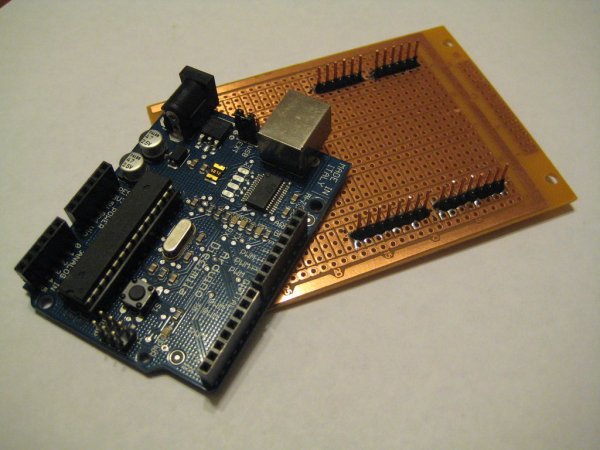also like the expandability that shields provide. My Arduino can be a GPS Locator
one minute, and be connected to the web the next. There’s also a kit that lets you make your own shields.
That last option always bothered me. If you’re making a bunch of different shields, the
cost of ProtoShields starts to add up. Wouldn’t it make more sense to just take a standard
prototype board from Radio Shack, get some connectors and slap THAT on my Arduino? Sadly, no.
One of the flaws with the Arduino’s design is that one of the female headers doesn’t align with
the standard 0.1″ spacing followed by, well, most electronics.
Mulling over this problem led me to my favorite type of solution: cheap & simple. By using wire instead of male headers, the misalignment can be handled with a simple bend.

Enjoy.
UPDATE: I’m embarrassed. Not one day after I posted this Instructable, I thought of a much better method, which I have documented here. This Instructable is still useful if you need a shield TODAY and don’t have any male headers. If you have some, however, or if you can afford to wait, the new method is faster, easier, and more robust.
Step 2: Insert Wires
- Remove some insulation. Leave yourself with about 1 inch of exposed wire.
- Sand off any burrs or rough spots from the end. This will make the final shield easier to insert and remove.
- Cut off ~3/4 inch (2cm) of wire and insert the sanded end into one of the female pins on the Arduino.
- Repeat (27 times) until all holes have a bare, sanded wire in them.
Step 3: Bend
To compensate for that pesky misalignment, give the wires on that header a slight bend.
Step 4: Mate
- Align wires with prototype board holes and slide board (metal towards Arduino) down until it is flush with the USB connector.
- Insert spacers and tape them in place. Why spacers? We want the shield to be level, we want it to clear the USB connector, and we need room for solder. (I used 3 flat toothpicks. you can use anything that’s the right thickness)
Step 5: Trim and Mask
- Trim the exposed wires so ~1/8 inch (2mm) of wire is left
- Use tape to mask off the area around the exposed wires. You’re going to want to use those holes later; let’s protect them.
Required Materials
Arduino
Radio Shack PC board (Available at every Radio Shack location I’ve ever visited)
Solid Wire (I used 20ga)
Sand paper
Wire strippers
Wire cutters
Flat toothpicks
Tape
Epoxy
Solder (and soldering iron)
For more detail: Arduino ProtoShield from Household Items
